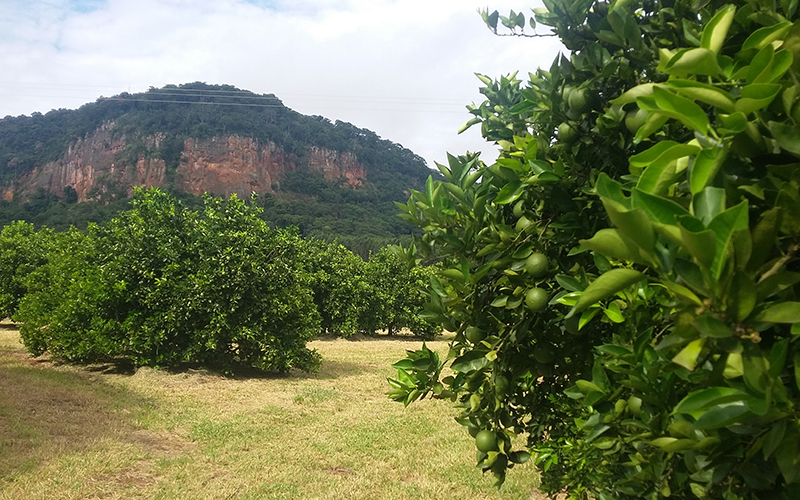Study shows the environmental contribution of the Brazilian citriculture
This year, the Crop Forecast Survey (PES) by Fundecitrus included a study in citriculture on the quantification of areas dedicated to the preservation of native vegetation and biodiversity on citrus farms in São Paulo and West-Southwest Minas Gerais, which showed that green areas total 181,750 hectares.

Citrus farms have 182 thousand hectares of native woods equivalent to one hectare of forest to every two and a half hectares of citrus
This year, the Crop Forecast Survey (PES) by Fundecitrus included a study in citriculture on the quantification of areas dedicated to the preservation of native vegetation and biodiversity on citrus farms in São Paulo and West-Southwest Minas Gerais, which showed that green areas total 181,750 hectares. The area allocated to citriculture on those same farms amounts to 459,058 hectares, i.e., there is one hectare dedicated to environmental preservation to every 2.52 hectares of citrus groves.
“For the first time it was possible to assess the environmental contribution of citriculture, which is quite considerable. This preserved fixed asset shows the commitment of the Brazilian citriculture to environmental sustainability”, says Fundecitrus general manager Juliano Ayres.
PES coordinator Vinícius Trombin explains that the perenniality of citriculture favors the preservation of flora and fauna, creating favorable conditions for animal life to thrive. “The bearing life of citrus trees is approximately 20 years, therefore intense earth moving is not frequent and the growing system involves low traffic of invasive equipment, keeping woods stable and safe to animals”, he clarifies. “Fruticulture also provides food to birds and small animals”, he adds.
Methodology by Embrapa Territorial
The quantification of the preserved area was based on a methodology developed by Empresa Brasileira de Pesquisa Agropecuária – Embrapa Territorial, with information of the complete mapping of the citrus belt performed by Fundecitrus in 2017 and data from the Rural Environmental Registry (RER).
According to head of Embrapa Territorial Evaristo de Miranda, information is relevant to protect the sustainability of the Brazilian production. “This work complements and enriches the analyses on the territorial dimension of areas designated to preservation of native vegetation by farmers who use the methods developed by Embrapa Territorial on their farms in the citrus belt with significant results, he comments.
Sustainable production
According to the Brazilian forest code, preservation of vegetation aims at conserving water resources, landscape, soil, biodiversity of flora and fauna and the well-being of the population.
In the assessment by researcher at the Instituto Internacional de Ecologia (IIE) José Galizia Tundisi, who specializes in the management of water resources, the rate between areas of native forests and citrus growing areas represents an important investment and a crucial example for sustainable production. “This initiative benefits not only the citrus production sector, but rather all society”, he states. “It has already been scientifically evidenced that areas of preserved native vegetation have quantitative and qualitative influence on the hydrological cycle and the spring water quality, as well as on the preservation of the land biodiversity”, he points out.
Biologist and researcher at the Centro de Estudos de Insetos Sociais of the Universidade Estadual Paulista (Unesp-Rio Claro) Osmar Malaspina also highlights the impact on the fauna. “These protected areas contribute to sustained biodiversity and help preserve pollinating species such as bees. The presence of pollinators generates a significant financial return to growers due to an increase of up to 50% in the quantity and quality of fruits produced”, he emphasizes.
In addition, data from the Instituto Brasileiro de Geografia e Estatística (IBGE) points to a large production of honey in the citrus belt. “Approximately 80% of the honey in the state of São Paulo is produced in cities where citrus is grown. In the region, the increase in honey production in the last decade was much greater than in cities that are not part of the citrus belt “, highlights Trombin.
In Aguaí (SP), the farm of citrus grower Richard Van Den Broek surpasses the 20% of preserved woods required by law. His family has been dedicated to citriculture for three generations, passing on the concern about the environment. In order to conserve the soil and the eight kilometers of the Itupeva river that cross the farm, the citrus grower employs no-till and contour farming. Animals such as puma, pampas deer, black capuchin and paca are often seen
– hunting and fishing are prohibited. Bees are kept in the woods as well.
“The farm was purchased in 2002 and already had a preservation area that demanded care, so all recommended good practices were adopted to maintain it”, he comments. “As long as growers respect the environment, they benefit the most, with preserved tributaries, water supply and a balanced ecosystem. We perceive that as wealth and are greatly pleased to know that flora and fauna are in harmony with citrus growing”, he says.









